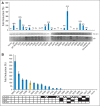Prevalence and functional consequence of TP53 mutations in pediatric adrenocortical carcinoma: a children's oncology group study
- PMID: 25584008
- PMCID: PMC4517369
- DOI: 10.1200/JCO.2013.52.6863
Prevalence and functional consequence of TP53 mutations in pediatric adrenocortical carcinoma: a children's oncology group study
Abstract
Purpose: Adrenocortical carcinoma (ACC) is a rare pediatric malignancy. It occurs in excess among individuals with the Li-Fraumeni syndrome, which results primarily from germline mutations in the TP53 gene. Prior series exploring frequencies of germline TP53 mutation among children with ACC have been small, geographically limited, or subject to referral bias. The functional consequence of mutations has not been related to phenotype. We provide a genotype-phenotype analysis of TP53 mutations in pediatric ACC and propose a model for tissue-specific effects based on adrenocortical ontogeny.
Patients and methods: Eighty-eight consecutive, unrelated children with ACC, unselected for family history, underwent germline TP53 sequencing. Rate and distribution of mutations were identified. Functional analysis was performed for novel TP53 variants. Correlation with the International Agency for Research on Cancer p53 database further delineated mutational distribution, association with family history, and risk for multiple primary malignancies (MPMs).
Results: Germline mutations were present in 50% of children. These mutations did not correspond to the conventional hotspot mutations. There was a wide range of mutant protein function. Patients bearing alleles encoding protein with higher functionality were less likely to have a strong family cancer history, whereas those with greater loss of function had MPMs and/or positive family history. In patients with MPMs, ACC was the most frequent initial malignancy. Finally, we demonstrated age-dependent rates of TP53 mutation positivity.
Conclusion: TP53 mutations are prevalent in children with ACC but decline with age. Mutations result in a broad spectrum of functional loss. Effect of individual mutations may predict carrier and familial disease penetrance with potentially broad implications for clinical surveillance and counseling.
© 2015 by American Society of Clinical Oncology.
Conflict of interest statement
Authors' disclosures of potential conflicts of interest are found in the article online at
Figures




References
-
- Parkin DM. Vol. II. Lyon, France: International Agency for Research on Cancer; 1998. International Agency for Research on Cancer: International Incidence of Childhood Cancer.
-
- Michalkiewicz E, Sandrini R, Figueiredo B, et al. Clinical and outcome characteristics of children with adrenocortical tumors: A report from the International Pediatric Adrenocortical Tumor Registry. J Clin Oncol. 2004;22:838–845. - PubMed
-
- DiGiammarino EL, Lee AS, Cadwell C, et al. A novel mechanism of tumorigenesis involving pH-dependent destabilization of a mutant p53 tetramer. Nat Struct Biol. 2002;9:12–16. - PubMed
-
- Lomax ME, Barnes DM, Hupp TR, et al. Characterization of p53 oligomerization domain mutations isolated from Li-Fraumeni and Li-Fraumeni like family members. Oncogene. 1998;17:643–649. - PubMed
Publication types
MeSH terms
Substances
Grants and funding
LinkOut - more resources
Full Text Sources
Research Materials
Miscellaneous

